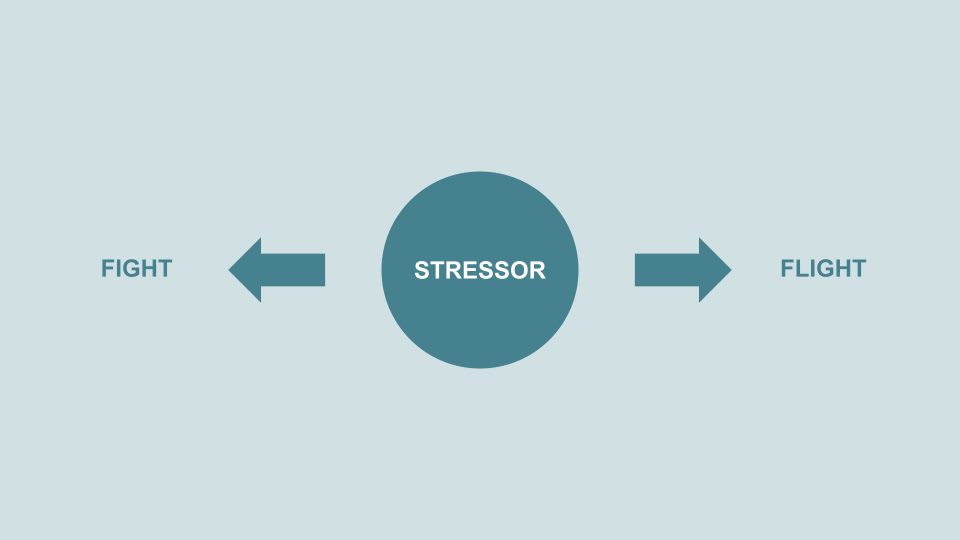Imagine standing on stage in front of a few hundred people. Your heart is beating fast, your hands are sweaty, and you can feel a knot in your stomach. This is the fight-or-flight response at play. While it may be helpful in dangerous situations, such as an encounter with a wild or angry animal or a narrow miss with a vehicle, the fight-or-flight response may become an obstacle in your daily work and life by preventing you from getting out of your comfort zone and tackling ambitious challenges.
An evolutionary response
The fight-or-flight response was first described by Walter Cannon in 1915 as a series of chain reactions that take place inside our bodies once we are brought face-to-face with a supposedly dangerous or threatening situation. This response helps the body quickly react in situations where speed is essential.
The human nervous system can be roughly divided into two parts: the central nervous system, that comprises the brain and the spinal cord, and the autonomic nervous system, which is further subdivided into the sympathetic and the parasympathetic nervous system.
When the eyes see an incoming threat or the ears hear something alarming, the brain’s amygdala, considered the emotional center of the brain, comes into action. It immediately sends a distress signal to the hypothalamus, which is a major part of the control center of the brain. Once the hypothalamus receives the signal, it sends it to the autonomic nervous system, which then sends it either to the sympathetic or the parasympathetic system to carry out the desired action as needed.
Why does it matter? Well, the autonomic nervous system controls the involuntary activities of the body such as breathing, heart rate, blood pressure, and digestion. The sympathetic nervous system, when activated, accelerates these activities, whereas the parasympathetic nervous system tones these activities down or brings them back to their normal or “relaxed” state.
When the initial signal sent to the hypothalamus was a stressful or alarming one, the sympathetic nervous system gets activated. It sends signals to the adrenal glands, which triggers the release of adrenaline. This activates the fight-or-flight response, releasing blood glucose so that the body does not run out of energy at any time during the entire response. Our whole body becomes tense, our heart rate and our blood pressure increase, we breathe faster: we are ready for action.
From an evolutionary perspective, the fight-or-flight response has been integral to our survival. However, it can sometimes get triggered by perceived psychological threats, and prevent us from achieving our goals. The good news is: in many cases, it is possible to manage the fight-or-flight response.
Managing the fight-or-flight response
When the fight-or-flight response gets excessively triggered, the body gets drained of its energy reserves, putting it under a constant state of exertion. In addition to creating obstacles in our work and life, this unwanted stress may lead to physical and mental health problems in the long run. These techniques can help toning down our fight-or-flight response so it supports our survival without getting in the way of a healthy, fulfilling life.
- Relaxation techniques. You can practice some easy relaxation techniques such as focused breathing, which has been shown to lower symptoms of anxiety and confusion. Visualization of calm scenarios and meditation can also help calm your mind.
- Counselling. If you repeatedly have your fight-or-flight response activated at unwanted times, it may be worth seeking professional help to explore potential phobias. Phobias are extremely common and considered by psychologists some of “the most common and easily treated mental disorders” — which makes them worth having a proper look at!
- Distraction. A simple way to manage your fight-or-flight triggers is to stop focusing on them and to redirect your attention. For example, a bit of physical activity can distract you from the stress. This is why you may see some performers do jumping jacks before getting on stage.
The fight-or-flight response is an inbuilt response that is stimulated when we feel threatened, whether the perceived threat is physical or psychological. The sympathetic and parasympathetic nervous systems both work in synchronization to activate or inactivate this stress response.
It is common for the fight-or-flight response to get overactivated, whether it is because we are getting out of our comfort zone, or because we have a deeply ingrained phobia that causes excessive fear. Whether you decide to try a few stress management techniques on your own or to seek help from a professional, understanding the fight-or-flight response will help you overcome some of your fears and achieve more in your work and life.

